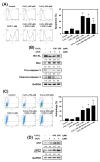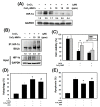The Oxygen-Generating Calcium Peroxide-Modified Magnetic Nanoparticles Attenuate Hypoxia-Induced Chemoresistance in Triple-Negative Breast Cancer
- PMID: 33546453
- PMCID: PMC7913619
- DOI: 10.3390/cancers13040606
The Oxygen-Generating Calcium Peroxide-Modified Magnetic Nanoparticles Attenuate Hypoxia-Induced Chemoresistance in Triple-Negative Breast Cancer
Abstract
Cancer response to chemotherapy is regulated not only by intrinsic sensitivity of cancer cells but also by tumor microenvironment. Tumor hypoxia, a condition of low oxygen level in solid tumors, is known to increase the resistance of cancer cells to chemotherapy. Triple-negative breast cancer (TNBC) is the most aggressive subtype of breast cancer. Due to lack of target in TNBC, chemotherapy is the only approved systemic treatment. We evaluated the effect of hypoxia on chemotherapy resistance in TNBC in a series of in vitro and in vivo experiments. Furthermore, we synthesized the calcium peroxide-modified magnetic nanoparticles (CaO2-MNPs) with the function of oxygen generation to improve and enhance the therapeutic efficiency of doxorubicin treatment in the hypoxia microenvironment of TNBC. The results of gene set enrichment analysis (GSEA) software showed that the hypoxia and autophagy gene sets are significantly enriched in TNBC patients. We found that the chemical hypoxia stabilized the expression of hypoxia-inducible factor 1α (HIF-1α) protein and increased doxorubicin resistance in TNBC cells. Moreover, hypoxia inhibited the induction of apoptosis and autophagy by doxorubicin. In addition, CaO2-MNPs promoted ubiquitination and protein degradation of HIF-1α. Furthermore, CaO2-MNPs inhibited autophagy and induced apoptosis in TNBC cells. Our animal studies with an orthotopic mouse model showed that CaO2-MNPs in combination with doxorubicin exhibited a stronger tumor-suppressive effect on TNBC, compared to the doxorubicin treatment alone. Our findings suggest that combined with CaO2-MNPs and doxorubicin attenuates HIF-1α expression to improve the efficiency of chemotherapy in TNBC.
Keywords: autophagy; chemoresistance; hypoxia; nanocarriers; triple-negative breast cancer.
Conflict of interest statement
The authors declare no conflict of interest.
Figures







References
-
- Shen M., Jiang Y.Z., Wei Y., Ell B., Sheng X., Esposito M., Kang J., Hang X., Zheng H., Rowicki M., et al. Tinagl1 suppresses triple-negative breast cancer progression and metastasis by simultaneously inhibiting integrin/FAK and EGFR signaling. Cancer Cell. 2019;35:64–80. doi: 10.1016/j.ccell.2018.11.016. - DOI - PubMed
Grants and funding
LinkOut - more resources
Full Text Sources
Other Literature Sources

